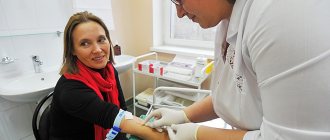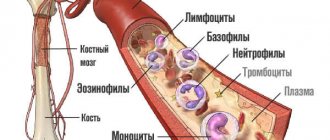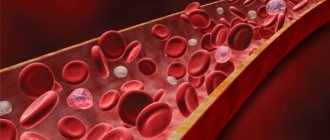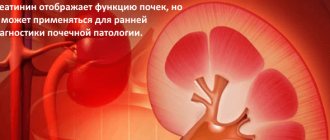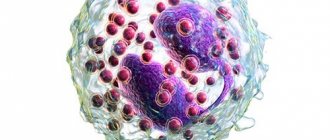13
Author of the article: Marina Dmitrievna
2017.09.02
32 467
Hemoglobin
People who pay close attention to their health usually feel better and worry less. A blood picture is one of the important indicators of the condition of the body. When all indicators are normal, this indicates the normal functioning of the body. What are the reasons for high hemoglobin in a teenager? What is the best way to adjust the metrics? Is this condition dangerous?
What levels are distinguished?
The protein level depends on the age of the person. A newborn's hemoglobin is 145-225 g/l, in the first months the figure drops to 95-135 g/l. It changes dramatically in the first year of life. Until the age of 12, the amount of protein constantly increases by 5 g/l, regardless of the child’s gender.
During puberty - from 12 to 18 years, differences begin. The hemoglobin norm in teenage girls and boys entering adolescence is 120-140 g/l. The indicator changes as you grow older. After reaching adulthood and up to 40 years of age, the level of protein concentration in the blood is 120-150 g/l for women, and 130-160 g/l for representatives of the stronger sex.
If adolescents have low or high hemoglobin, they should be examined to rule out the development of serious pathologies. Blood protein levels are just a symptom, not a disease.
Low hemoglobin causes in a teenager
As a rule, a woman learns about the phrase “low hemoglobin” during pregnancy. It is thanks to the mother that normal indicators of its level are laid in the baby’s body. During pregnancy, the baby receives the necessary iron reserves and they last until the baby is six months old. In some cases, it happens that hemoglobin in children is low. What to do?
What are iron-containing blood cells and what is their function?
Hemoglobin is a protein found in the blood of those animals that have a circulatory system. Its main function is to transport oxygen to the organs and tissues of the body.
This substance functions as a kind of postman, receiving the “goods” in the lungs and carrying oxygen throughout human cells. However, it does not return empty, but along with carbon dioxide.
How is hemoglobin level determined?
A clinical blood test using a special analysis helps to identify low hemoglobin in a child at a certain point. It is carried out in a laboratory and in the process the number of blood cells is determined, as well as their content per liter of blood in grams.
How is the analysis done?
- A healthcare worker trying to find out why a child has low hemoglobin takes blood from a finger prick for testing. The indicators vary and depend on the time of the procedure, as well as on the food consumed beforehand. To get reliable results, it is advisable to take this test in the morning, on an empty stomach.
- Sometimes, to identify the causes of low hemoglobin in children, it is necessary to compare data from several blood tests. Here it is important to do everything necessary to ensure that the conditions for blood sampling are as identical as possible.
Based on the data received, the doctor prescribes treatment.
Table of norms for hemoglobin indicators in children of different ages
Before you figure out what to do with low hemoglobin in children, you need to understand that its level fluctuates and, above all, depends on the age of the baby.
Thus, tests will reveal a greater amount of hemoglobin and red blood cells in the blood of a newborn baby than in older children.
In the first 12 months of a child’s life, there is a natural decrease in the level of iron-containing protein in the blood, and this is acceptable for infants.
Hemoglobin level in the blood of children under one year of age:
| Baby's age | Ideal g/l value | Permissible norm g/l |
| 1st 24 hours of life | 220 | 180-240 |
| Fifth day | 190 | 160-200 |
| Tenth day of life | 180 | 160-190 |
| First month | 175 | 160-190 |
| Two month | 150 | 120-160 |
| Three months | 140 | 120-160 |
| 120 days | 135 | 120-140 |
| Five months | 135 | 120-140 |
| Six months of life | 130 | 120-140 |
| Seven months | 130 | 120-140 |
| Eight months | 130 | 120-140 |
| Nine month | 130 | 120-140 |
| Ten months | 125 | 110-140 |
| Eleven months | 125 | 110-140 |
| Year of life | 120 | 110-140 |
What level is acceptable for premature babies?
Mothers are concerned about the causes of low hemoglobin in children who were born prematurely. These babies have lower rates than those babies who were born on time.
So, the lower permissible limit is 160 g/l. At the same time, by the thirtieth day of life of a premature baby, the hemoglobin level drops, and the lower norm is 100 g/l. If the indicator reaches 85 g/l or less, then this condition is very dangerous and requires immediate blood transfusion.
Average hemoglobin level in children from 1 to 7 years old
| Baby's age | hemoglobin, norm, g/l | Allowable variations, g/l |
| 12 months | 120 | 110-140 |
| 18 months | 120 | 110-140 |
| 24 months | 125 | 110-140 |
| 36 months | 125 | 110-140 |
| 4 years | 125 | 110-140 |
| 5 years | 130 | 120-140 |
| 6 years | 130 | 120-140 |
| 7 years | 130 | 120-140 |
Upon reaching one year of age, the baby actively consumes meat and plant products, thereby replenishing the reserves of various microelements, including iron. If the child’s body receives the required amount of iron, after 14-18 months of his life, independent synthesis of blood cells in the body begins.
Several factors that affect hemoglobin levels
When trying to figure out what to do with low hemoglobin in children, you should understand that its content in the blood depends on several points:
- Age characteristics. Infants who have just been born have the highest concentration of hemoglobin levels. Then it decreases. So, an indicator of 120 g/l indicates low hemoglobin in a child at 3 months, and for a one-year-old baby this is the norm.
- Mother's pregnancy. If a woman had hematopoietic diseases during pregnancy or suffered global blood loss during childbirth, this will affect the baby’s hemoglobin level. As well as a history of premature birth and multiple pregnancies.
- Food. If a child is breastfeeding, then low hemoglobin will be observed occasionally. Artificial children suffer from deficiency more often. Also, the level of hemoglobin indicators can be affected by a violation in the diet of a baby who is older than six months. For example, if the mother does not introduce complementary foods for a long time, does not give the baby meat, etc.
- Health. Reduced hemoglobin in a child can be observed if the baby has hidden diseases.
- Heredity. If the child’s parents have long-term anemia, it is not surprising that this condition will be passed on to the baby.
- Seasons. The greatest drop in hemoglobin levels in the blood of children is observed in autumn and winter.
What can low hemoglobin in a child indicate?
A low level indicates that the baby has iron deficiency anemia. However, a low level can also indicate:
- Hemolytic type anemia, which leads to the destruction of red blood cells.
- A condition caused by a deficiency of vitamins B12 and B9 and others belonging to this group.
- Acute bleeding after injury or surgery.
- Crohn's disease and hemophilia, as well as other intestinal and blood diseases.
- Worm infestation.
- Chronic bleeding.
- Infectious diseases.
- The presence of allergic reactions and tumors.
Anemia can also occur after taking certain medications.
Signs of the condition
Before you understand what to do with low hemoglobin in children, you need to understand what the signs of the disease are. So, the manifestations are as follows:
- The skin is pale.
- The child is lethargic and gets tired quickly.
- The baby experiences weakness, dizziness and circles under the eyes.
- The baby wants to sleep.
- The child's temperature rises and the structure of the nail plates changes.
- The baby eats and sleeps poorly and is mostly in a bad mood.
- The baby often picks up viral infections, his skin peels and becomes dry.
If the described symptoms appear, you need to consult a doctor, otherwise the baby will develop tachycardia, shortness of breath and will lag behind in development.
How to increase hemoglobin?
How to quickly increase hemoglobin in a child’s blood? First of all, you need to understand that you cannot self-medicate and cannot do without consulting a pediatrician. Only a specialist can determine the cause of the disease and prescribe the correct therapy.
The baby’s hemoglobin rises in the following ways, depending on the indicators:
- If the value is from 100 to 110 g/l, you can adjust your diet and try to do without medications. Meat is introduced into the baby’s diet, which should be eaten along with vegetables for better absorption of iron. Milk, coffee and tea are excluded from the child’s diet. You need to watch your child's gums. If they bleed, consult a dentist. A month later, blood is donated again to identify positive dynamics.
- At a level of 90-100 g/l, there is no need to think whether hematogen increases hemoglobin or not, because here you cannot do without additional iron supplements. You need to select them carefully. It is better to give preference to ferric iron in tablets, which are easily absorbed. You should take the drug for a month, and then you need to repeat the blood test again.
- The indicator is 60-90 g/l. With this value, iron solutions are prescribed orally or in the form of injections. In this case, only a doctor knows how to quickly increase hemoglobin in the blood. The situation is monitored by blood sampling, which is carried out every 10 days.
- The level is below 60 g/l - in this case, an urgent blood transfusion is required, otherwise the child’s life will be in danger. Treatment is carried out in a hospital.
List of products
Does Hematogen increase hemoglobin or not? Definitely yes!
However, the following foods should be included in your child’s diet:
- chicken, pork and beef liver;
- heart;
- poultry (turkey, chicken), as well as pork, beef and lamb;
- sardines;
- quail and chicken egg yolk;
- tongue of boar and cow.
What do you eat to increase hemoglobin from plant products?
- pistachios, lentils and spinach;
- oatmeal;
- peas;
- buckwheat and barley cereals;
- wheat;
- peanuts and cashews;
- corn and dogwood;
- Pine nuts.
Products of plant and animal origin must be combined. Doctors answer the question “Does Hematogen increase hemoglobin or not?” positive, but it is an auxiliary substance. The diet will have to be revised.
Complications and consequences
Why is low hemoglobin dangerous in a child? The consequences of the disease vary, especially over a long period of time. They negatively affect the baby’s quality of life and can affect his fate. The most dangerous consequences are as follows:
- Decreased immunity and growth retardation.
- Heart failure caused by anemia, namely increased load on the heart.
- Delayed mental and physical development.
- Leukemia.
- Bone marrow dysplasia.
- Fatal outcome due to genetic defects and large blood loss.
- Transition to the stage of chronic disease.
If we are talking about the iron deficiency form of the disease, unpleasant consequences can be avoided if you contact your pediatrician for help in time and strictly follow the prescribed therapy. But in some cases, with serious disorders of hematopoietic functions, medicine may be powerless.
Reduced hemoglobin
A viral infection can lower hemoglobin levels. This condition can lead to anemia. When the disease occurs, a huge number of red blood cells accumulate at the site of inflammation, and in other parts of the body the blood becomes more liquid and contains a small number of blood cells, which is why inflammatory anemia develops. Upon recovery, the blood condition stabilizes, red blood cells begin to move throughout the plasma, and health returns to normal.
Low hemoglobin in a teenager can occur in case of frequent bleeding, especially in girls during restructuring of the body. They are associated with the menstrual cycle, which is chaotic during adolescence, constancy comes only in adulthood. During the process of becoming a woman, severe uterine bleeding may occur.
Hemoglobin is formed from iron. If there is not enough of it in the body, protein formation becomes difficult, and the level of the indicator drops sharply. The result is anemia. If hemoglobin in adolescents is below normal, the child becomes lethargic, his brain begins to work poorly, drowsiness and fatigue are observed. Most of the children study in schools and colleges. Their general condition may affect their grades, acceptance, and learning of information received in educational institutions.
The formation of hemoglobin is promoted by cyanocobalamin - vitamin B12. If a teenager has poor absorption of this vitamin, protein levels will be low. With such indicators, disturbances in brain function, memory deterioration, and a decrease in the body’s defenses are observed.
Reasons for the increase
Often a slight increase in hemoglobin in the blood is associated with physiological processes and is a temporary phenomenon. Develops due to lack of fluid in the body, physical activity, prolonged stress, unbalanced diet, lack of sleep, etc. Usually the indicators return to normal after eliminating these factors.
Sometimes high Hb indicates the following serious health problems:
- oncological pathologies;
- disruption of adrenal hormone production;
- blood diseases;
- extensive burns;
- diabetes;
- diseases of the heart, blood vessels and lungs;
- intestinal obstruction;
- infectious diseases.
Many teenagers start smoking early, which can also cause an increase in hemoglobin concentration.
Often abnormalities in a general blood test are discovered by chance when young people undergo examinations. For example, when applying to study, to the sports section.
Does heredity have an effect?
Anemia can be inherited. If during pregnancy the mother experienced anemia or there was heavy bleeding during childbirth, then the child may have abnormalities. When examining a teenager, this indicator is taken into account.
Any reason for a decrease in protein levels can cause dizziness and nausea. Nails will become brittle, hair will become dull, skin will become dry and begin to peel, and bruises will appear on the body. For girls and boys during the period of maximalism, when they are fixated on their appearance, these symptoms can cause severe depression and stress. More serious consequences may include: hallucinations and fainting, lack of appetite, brain hypoxia and paralysis of the respiratory system.
What are the dangers of hemoglobin fluctuations?
High hemoglobin in the blood is characterized by poor blood circulation through the vessels due to its thickening. If you do not respond to the changes, then there is a possibility of blood clots and blockage of blood vessels. With a constant high concentration of protein, the functioning of internal organs is disrupted and brain activity deteriorates.
Iron deficiency anemia is a frequent companion to a decrease in Hb. The disease can significantly worsen a teenager's quality of life. Such children get sick more often, constantly feel weak, and they lose interest in learning and communicating with friends. If the reason for the change in the indicator is not identified and treatment is not started, then fluctuations in iron-containing protein in the low or high direction can lead to serious consequences for the child’s body. Only eliminating the root cause will help restore normal Hb levels in the blood.
Increased hemoglobin - what does it mean?
With lung diseases, respiratory failure often occurs, so the body begins to produce red blood cells to stock up on the necessary amount of oxygen.
The indicator level may be high due to dehydration. In cases of infectious diseases accompanied by vomiting and persistent diarrhea, fluid is excreted in large quantities. The blood becomes thick and its circulation slows down. To prevent dehydration, the patient should drink plenty of fluids. The same applies to intestinal obstruction and frequent constipation.
Increased hemoglobin can lead to disruption of the cardiovascular system. Especially its indicator should be taken into account in case of congenital heart defects, respiratory failure and other diseases.
Extensive burns cause a sharp increase in red blood cells. Oncological diseases and pathological blood diseases contribute to an increase in red blood cells in the blood, since their increased formation is observed in the bone marrow. When there is a damaged area in the body, red blood cells begin to actively transport oxygen to the site of the disease.
An increase in their number can cause severe disturbances in the functioning of the circulatory system. This will lead to dysfunction of most organs. The blood will become thick and will poorly supply tissues and cells. Blood circulation will slow down, and various organs will increase in size, for example, the spleen, kidneys, and liver. Blood clots will form thrombi, which can block blood vessels and cause heart attacks.
If, at the age of 17, a teenager’s hemoglobin exceeds the norm for a long time, this can lead to complications and even death.
General information about hemoprotein
To understand why high hemoglobin is corrected in a 14-16 year old teenager, it is worth understanding what this substance is and why the human body needs it.
Hemoglobin is a protein. This compound is transported through the blood by red blood cells. Hemoglobin contains iron. This component has an amazing reversible ability to bind to oxygen molecules. Thanks to this property, the exchange of oxygen and carbon dioxide between organs and tissues, that is, cellular respiration, becomes possible.
Attention! It is the hemoglobin molecules that color the blood red.
Red blood becomes this way only because of the hemoglobin molecules it contains.
Increased hemoglobin in a teenager 14 years of age and older cannot be ignored. This either indicates the presence of some kind of pathology, or can lead to serious problems.
Recommendations
If there are changes in hemoglobin levels, you should not self-medicate so as not to harm the body. When contacting a specialist, the teenager will be prescribed an individual course of therapy and a strict diet. The doctor must conduct a full examination of the body in order to make a correct diagnosis, take into account the severity of the disease, the age and gender of the teenager, and check for allergic reactions and intolerance to medications. It should be remembered that almost any pathology can be treated in the early stages.
Increased hemoglobin and red blood cells: causes and treatment
If the child’s hemoglobin and red blood cells are elevated, a repeat blood test is indicated to rule out a laboratory technician’s error. If confirmed, an additional examination is carried out, which becomes the basis for selecting treatment tactics.
INTERESTING: elevated red blood cells and protein in the urine of a child: symptoms and norms
Initially, the causes of the pathology are clarified. In addition to those mentioned above, at any age the following factors are taken into account:
- Accommodation in high altitude areas. In mountainous regions the air is thinner. The child's body requires more oxygen. It adapts and produces more red blood cells that can carry O2.
- Taking certain medications. When determining why the indicator is overestimated, doctors exclude this factor first.
In addition to treating the underlying pathology and taking blood-thinning medications, parents are recommended to:
- Observe the baby's drinking regime, limit fatty foods and foods high in iron in the baby's diet. You should not give your baby beef, beans, dogwood, buckwheat, or red fruits.
- Add more chicken, seafood, and fish to your diet. It is advisable to prepare boiled dishes - during such culinary processing of food, part of the iron is destroyed and goes into the broth.
- Avoid taking vitamin complexes containing vitamins B and C. When the baby is breastfed, all of the above recommendations apply to the mother’s diet.
- Air humidification. In the room where the baby sleeps and plays, the air humidity should be at 50 - 70%. To maintain it, you should use a humidifier or hang clean, wet diapers. The room should be ventilated regularly. Long walks and moderate physical activity are recommended.
What foods to eat?
Hemoglobin levels can be increased by eating iron-containing foods, so you need to add to your diet:
- some types of cereals - buckwheat and oatmeal;
- egg yolks;
- turkey, pig, beef liver;
- greens in any form;
- walnuts;
- fruits - apples, apricots, peaches, grapes, pomegranate;
- vegetable and fruit juices;
- vegetables – carrots, tomatoes, beets;
- legumes
But if the hemoglobin level in adolescents exceeds the norm, the above foods should be excluded from the diet.
How to increase hemoglobin without medications?
The approach to treating low hemoglobin in children should be comprehensive (we recommend reading: low hemoglobin level in a child: causes and consequences). It is important to understand that without taking iron supplements it is not easy to raise the indicator to the lower limit. In addition to medications, the following measures are necessary:
- A diet high in iron-containing foods. These are peanuts, beef, liver, legumes, dogwood, spinach, pistachios. To quickly digest these products, you should limit foods high in calcium: yoghurt, kefir, cottage cheese, milk.
- Walks in the open air. You should not overload your child with active physical exercise. With anemia, he feels muscle weakness. Slow walks saturate the body with oxygen, which stimulates the formation of red blood cells.
- Folk recipes. A decoction of crushed rose hips, a mixture of honey, dried apricots, raisins and walnuts, fresh fruit and vegetables (a mix of apple, carrot and beet juice in a ratio of 2:1:1).
Smoking as a cause of disease
Those who do not know what hemoglobin depends on should also pay attention to bad habits. Smoking can affect hemoglobin levels. A cigarette smoked on an empty stomach can lead to intoxication of an unformed body in 90% of cases. Poisoning does not go away without a trace, symptoms appear depending on the severity. If diarrhea or vomiting begins, dehydration will occur, accompanied by increased production of red cells.
The smoker will first be excited, which will lead to rapid breathing and heart failure. Then a phase of inhibition may occur with a slowing of the heartbeat and a drop in blood pressure. Without medical attention, a teenager may develop heart or respiratory failure.
Causes of high hemoglobin in a child
If a child’s blood has increased hemoglobin, then we can talk about serious pathologies:
- neoplasms;
- congenital heart disease or “cardiac PDA”;
- heart failure;
- intestinal obstruction;
- blood pathologies;
- pulmonary fibrosis or other diseases of the respiratory system, for example, pneumonia;
- kidney disease;
- thermal burns;
- dehydration, which leads to blood thickening.
Also, increased hemoglobin may not indicate serious illness, but at the same time, you should definitely pay attention to the following things:
- severe overwork, for example, among schoolchildren;
- excessive physical activity;
- stress;
- taking certain medications;
- stay in the mountains;
- ecology in the city.
The reasons for increased hemoglobin in a child of high school age may not indicate illness, but tell about the unpleasant problems of a teenager, which also need to be taken a closer look at, for example, smoking, severe stress, and taking anabolic steroids.
We take care of our health
With an increase in hemoglobin, body temperature can rise to 37.2 degrees. This must be taken into account when a teenager is actively involved in any sport. In this case, it is worth checking the blood for the presence of anabolic steroids. The substances help with endurance, but worsen the body’s well-being, which will manifest itself several years later.
Improper or insufficient nutrition causes deviations in the indicator. It is common for a teenager to snack on sandwiches rather than warm up first and second meals. He is selective in food and may not eat well. Not eating meat and red foods can lead to iron deficiency in the body. Products must contain folic acid and vitamin B12 in sufficient quantities.
The hemoglobin level in adolescents must be monitored all the time, because the indicator can change depending on the natural conditions in which the child lives.
Hemoglobin is produced in large quantities in people living in mountainous areas. The higher the mountains, the lower the oxygen content in the air and the harder it is to breathe. Because of this, tissues and organs do not receive it in the quantity they need, and the body begins to produce additional iron-containing elements. Under such conditions, adolescents have elevated hemoglobin levels.
Hemoglobin norm for children over 12 years old
Hemoglobin (Hb) is a complex protein that is part of red blood cells. Its main task is to transport oxygen to all tissues and organs. A normal level of Hb in the blood is necessary for the coordinated functioning of the whole body. For children under 12 years of age, the normal hemoglobin level is the same for boys and girls. After 12 years, gender makes its own adjustments to the blood test. Therefore, the norm for boys and girls in adolescence is different.
| Age period | Hb norm for boys (g/l) | Hb norm for girls (g/l) |
| 12-14 years old | 120-160 | 115-150 |
| 15-18 years old | 122-163 | 117-153 |
After age 18, Hb levels for healthy men and women remain stable until age 65.
Iron deficiency conditions in adolescents: principles of correction
One of the important areas in pediatrics is adolescent medicine, or hebiatics, a branch of medicine that studies the processes of puberty, maturation, growth and development of the adolescent’s body, as well as specific diseases characteristic of the teenage period of life.
The puberty period has its own unique characteristics, due to powerful vegetative, endocrine and immune restructuring of the body against the background of a physiological growth spurt, as well as disorders of psychosocial adaptation. It is at this time that numerous transient functional disorders form and previously hidden organic defects appear: hypothalamic dysfunction, with a wide range of clinical manifestations (vegetative-vascular dystonia, metabolic syndrome, etc.), congenital inferiority of connective tissue (visceroptosis, articular hypermobility, osteochondrosis, etc.) , which helps reduce adaptation to the influence of the external environment. It should be noted that nosological forms during this age period have significant differences. Thus, diseases of the endocrine, nervous and musculoskeletal systems dominate in adolescents, while infectious and colds are more often registered in young children, and in adults the frequency of neoplasms and diseases of the circulatory system increases. This age is characterized by polysystemic (polymorbidity) diseases. For example, in a girl who considers herself practically healthy, a thorough examination is diagnosed with dysmenorrhea, iron deficiency, poor posture, flat feet, nephroptosis, instability of the cervical spine, chronic tonsillitis, myopia, irritable bowel syndrome with constipation, biliary tract dysfunction, crystalluria.
Iron deficiency is one of the pressing problems of adolescence. A decrease in the amount of iron in the body leads to a disruption in the formation of hemoglobin and a decrease in the rate of its synthesis, the accumulation of free protoporphyrin in erythrocytes, the development of hypochromic anemia and trophic disorders in organs and tissues.
At present, there is no doubt that the main factor contributing to the development of iron deficiency anemia in adolescents is the discrepancy between iron reserves in the body and its needs.
Iron deficiency in adolescence is much more common in girls, which may be due to heavy menstruation. However, in cases where the need for iron far exceeds its supply, iron deficiency anemia can also develop in young men. The most common reasons in this case are the intensive growth of a teenager, participation in strenuous sports, initial low iron levels against the background of an unbalanced diet, and vegetarianism. It should be remembered that iron deficiency anemia is often observed in conditions such as anorexia nervosa, idiopathic pulmonary hemosiderosis, Goodpasture's syndrome, atransferrinemia, collagenosis, diseases of the stomach and duodenum, including those associated with H. pylori, repeated intestinal infections, giardiasis, helminthic infestations, inflammatory bowel diseases, infectious diseases (tuberculosis, brucellosis, mycosis, etc.), as well as in chronic renal failure and during dialysis treatment [1, 2].
There are prelatent iron deficiency (iron reserves are depleted only from the depot while maintaining the transport and hemoglobin funds of iron), latent iron deficiency (accounts for 70% of all iron deficiency anemias) and iron deficiency anemia (accounts for 30% of all iron deficiency conditions) (Table).
The clinical picture of iron deficiency anemia consists of two leading syndromes: anemic and sideropenic. The latter is characterized by dystrophic changes in the skin and its appendages; perversion of taste and smell, muscle pain (due to myoglobin deficiency), muscle hypotension, changes in nervous regulation.
It should be noted that the clinical manifestations of the disease in adolescence differ from those in young children. Thus, koilonychia, blue sclera (the choroid is visible through the thinned sclera), taste and olfactory disturbances, dysphagia, and dyspepsia are more typical for them.
Diagnosis of iron deficiency conditions is based on the determination of the laboratory parameters presented above. The main criterion is the ferritin content in the blood serum [3]. However, if it is impossible to determine this indicator, you can focus on the level of hemoglobin, the determination of which is available in any medical institution.
It is advisable to annually determine the hemoglobin level in girls who have heavy blood loss during menstruation or another nature, low dietary iron intake (dietary restrictions for weight loss, vegetarianism, etc.), and a history of iron deficiency anemia of various nature. Boys need to monitor their hemoglobin levels if they are intensely involved in strenuous sports (athlete's anemia).
In all cases of iron deficiency, it is necessary to establish the immediate cause of its occurrence and, if possible, eliminate it (eliminate the source of blood loss, treat the underlying disease, complicated by sideropenia). Treatment should be comprehensive and aimed not only at eliminating anemia as a symptom, but also at eliminating iron deficiency and replenishing its reserves in the body.
It is necessary to enrich a teenager’s diet with foods that are the main sources of iron, and not only the amount of iron in a particular product matters, but also the degree of its absorption and the possibility of assimilation by the body.
Meat, especially red meat (veal, beef, lamb), is the best source of heme iron; 20–25% of iron is absorbed from it. Iron from chicken and pork is absorbed to a lesser extent. And in liver and fish, iron is contained in the form of ferritin and hemosiderin, so it is absorbed even worse.
Non-heme iron (vegetables, fruits, nuts) is poorly absorbed (1–5%), and its absorption is influenced by many factors that can either improve or worsen its absorption. Thus, they enhance the absorption of iron: vitamin C (especially abundant in citrus fruits), hydrochloric acid (found in gastric juice), fructose (fruits, honey). Impair iron absorption: drugs that reduce the acidity of gastric juice (antisecretory drugs, antacids), calcium (a lot in dairy products), oxalates (spinach, cabbage, beets, nuts, chocolate, tea, etc.), polyphenols (cocoa, coffee, black and some types of herbal tea), phytic acid (walnuts, almonds, legumes, bran) [4].
However, once anemia has developed, it cannot be cured with diet alone: iron deficiency anemia is treated with iron supplements. Nutrition helps maintain a normal iron balance in the body after treatment.
The most commonly used iron compounds in pediatric practice include ferric iron preparations, polymaltose hydroxide and ferrous iron salts - sulfate, fumarate, chloride and gluconate. To improve absorption, ferrous salts are combined with organic acids, amino acids and other compounds. Preference is given to oral forms, since compared to parenteral administration, the rate of recovery of hemoglobin levels is almost the same, and the number of side effects is sharply reduced. Taking iron supplements is recommended 1 hour before meals, preferably in the evening, since the process of iron absorption increases in the second half of the day.
The therapeutic effect of oral iron intake appears gradually. The first positive clinical sign is the disappearance or reduction of muscle weakness. On days 8–12 from the start of treatment, the content of reticulocytes in the peripheral blood increases. Normalization of hemoglobin occurs by 4–5 weeks from the start of therapy.
In recent years, in the treatment of iron deficiency conditions in adolescents, a new generation of iron-containing drugs based on the polymaltase complex of ferric hydroxide - Maltofer and Maltofer Fol - has been actively used, which in addition to iron contains folic acid, which takes part in the production of nucleic acids, purines, amino acids that stimulate erythropoiesis.
The results of using Maltofer are assessed positively by various authors [5]. One of the attractive characteristics of this drug is its low toxicity. The drug is well tolerated, has a pleasant taste and is in the form of chewable tablets, which undoubtedly increases adherence to therapy. For iron deficiency anemia, children and adolescents aged from one to 12 years are prescribed Maltofer at a dose of 50–100 mg per day, for latent deficiency and for the prevention of iron deficiency - 25–50 mg per day. Children and adolescents over 12 years old - 100-300 mg per day, and for latent iron deficiency and for preventive purposes - 50-100 mg per day. The duration of therapy, as a rule, is at least 2 months, which is determined by the degree of iron deficiency in the body and depletion of its reserves, the rate of hematopoiesis, and absorption. In the case of clinically pronounced iron deficiency, normalization of hemoglobin is achieved only 2–3 months after the start of treatment. To restore internal iron reserves, administration in prophylactic doses should be continued for several months. If blood loss continues, it is necessary to carry out preventive courses of treatment with an iron preparation (1 month 2–4 times a year).
Literature
- Korovina N. A., Zaplatnikov A. L., Zakharova I. N. Iron deficiency anemia in children (a guide for doctors). M., 1999. P. 64.
- Finogenova N. A., Chernov V. M., Morshchakova E. F. et al. Anemia in children: diagnosis and treatment. M., 2000. pp. 9–17.
- Finogenova N. A., Chernov V. M., Morshchakova E. F. et al. Anemia in children. Diagnosis, differential diagnosis, treatment. M., 2004. pp. 20–64.
- Gorodetsky V.V., Godulyan O.V. Iron deficiency conditions and iron deficiency anemia: treatment and diagnosis (methodological recommendations). M., 2006. P. 25.
- Soboleva M.K. Experience in using the drugs Maltofer and Maltofer Fol in the treatment of iron deficiency anemia in children and adolescents // Siberian Consilium. 2003, No. 1, p. 79–82.
T. A. Bokova1, Candidate of Medical Sciences G. V. Maslikova, Candidate of Medical Sciences
GBUZ MO MONIKI named after. M. F. Vladimirsky, Moscow
1 Contact information
Buy an issue with this article in pdf

